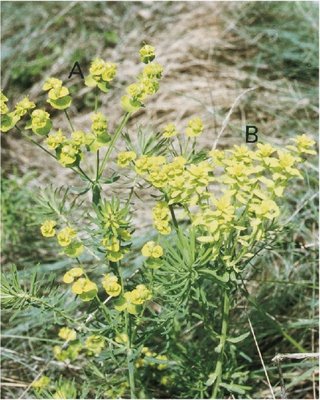Mimicry is a fascinating and widespread phenomenon where one organism gains some benefit by resembling another organism or thing. This resemblance can take many forms including visual, chemical and molecular mimicry.
A mini review in FEMS Microbiology Letters (1) has stimulated my interest in the little known mimetic interactions of plants and fungi.
There are several ways that fungi can imitate plants and manipulate them or use them to manipulate other organisms. One particularly fascinating mechanism is the production of ‘pseudoflowers’ that is structures formed from the leaves of a plant infected by fungi that resemble flowers, they also smell like flowers and exude sweet liquid as a reward. This liquid contains fungal spores and when pollinating insects land on the pseudoflowers they pick up spores and transfer them to other flowers that the fungus can then infect. I am just amazed by this type of manipulation, it will be fascinating to learn just how this remarkable feat is achieved and how it evolved.


Pseudoflower of an Arabis produced by the fungus puccinia monoica (3)
Fungi can also act as molecular mimics tricking the host plant into thinking that they are grains of pollen. This allows them a fantastic entry route into the plant bypassing the physical barriers found in the rest of the plant. The Stigmas of plants have evolved to capture pollen grains from the air. The normal pollen floats in the air in a similar ways to fungal spores and so end up on stigmas in a similar way. There is also some evidence that molecules on the surface of the growing fungus contain similar molecules to pollen. A similar trick is accomplished by several pathogens where surface molecules resemble those of the host.
While writing this I saw an interesting post at Thomasburg walks via the carnival of animalcules. I am not sure if they are flower mimics, they certainly look like flowers. It would be interesting to find out if they attracted pollinating insects to disperse them, or if in this case the resemblance to flowers in coincidental.
Refs:
1) Mimicry in plant-parasitic fungi
Henry K. Ngugi & Harald Scherm
FEMS Microbiol Lett 257 (2006) 171–176
2) POLLINATOR-MEDIATED INTERACTIONS BETWEEN A PATHOGENIC FUNGUS, UROMYCES PISI (PUCCINIACEAE), AND ITS HOST PLANT, EUPHORBIA CYPARISSIAS (EUPHORBIACEAE).
MONIKA PFUNDER AND BARBARA A. ROY
American Journal of Botany 87(1): 48–55. 2000.
3) Floral mimicry by a plant pathogen
B. A. Roy
Nature 362, 56 - 58 (04 March 1993) ; doi:10.1038/362056a0
http://evolution.uoregon.edu/Publications.htm


1 comment:
Do you like playing in the game which you need to use maple mesos, when you do not have mesos, you must borrow cheap mesos from friends, or you buy maplestory mesos. If you get maple story mesos, you can continue this game.
Post a Comment